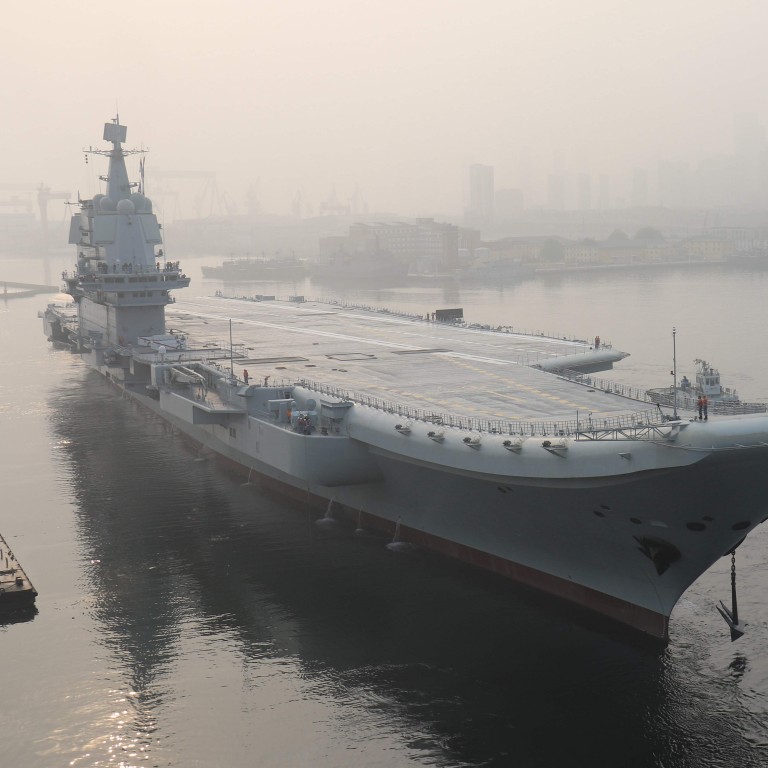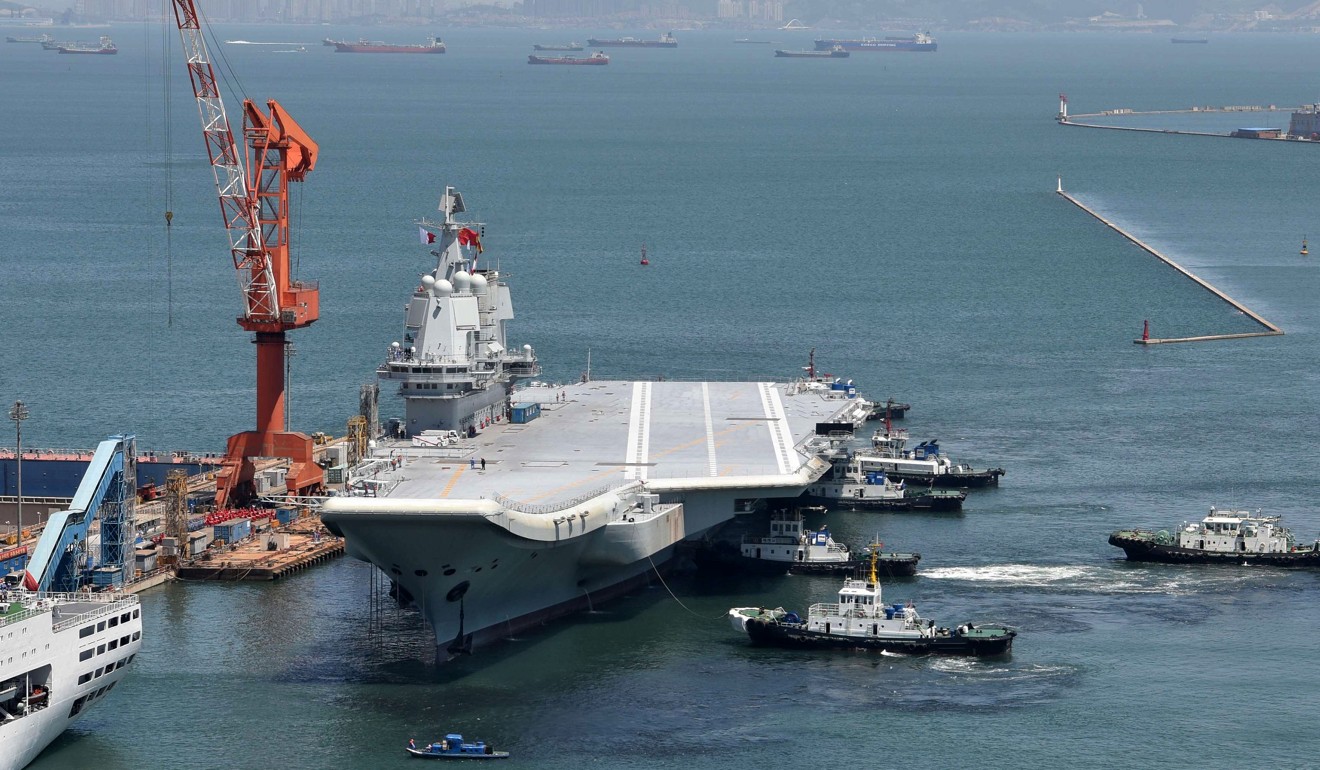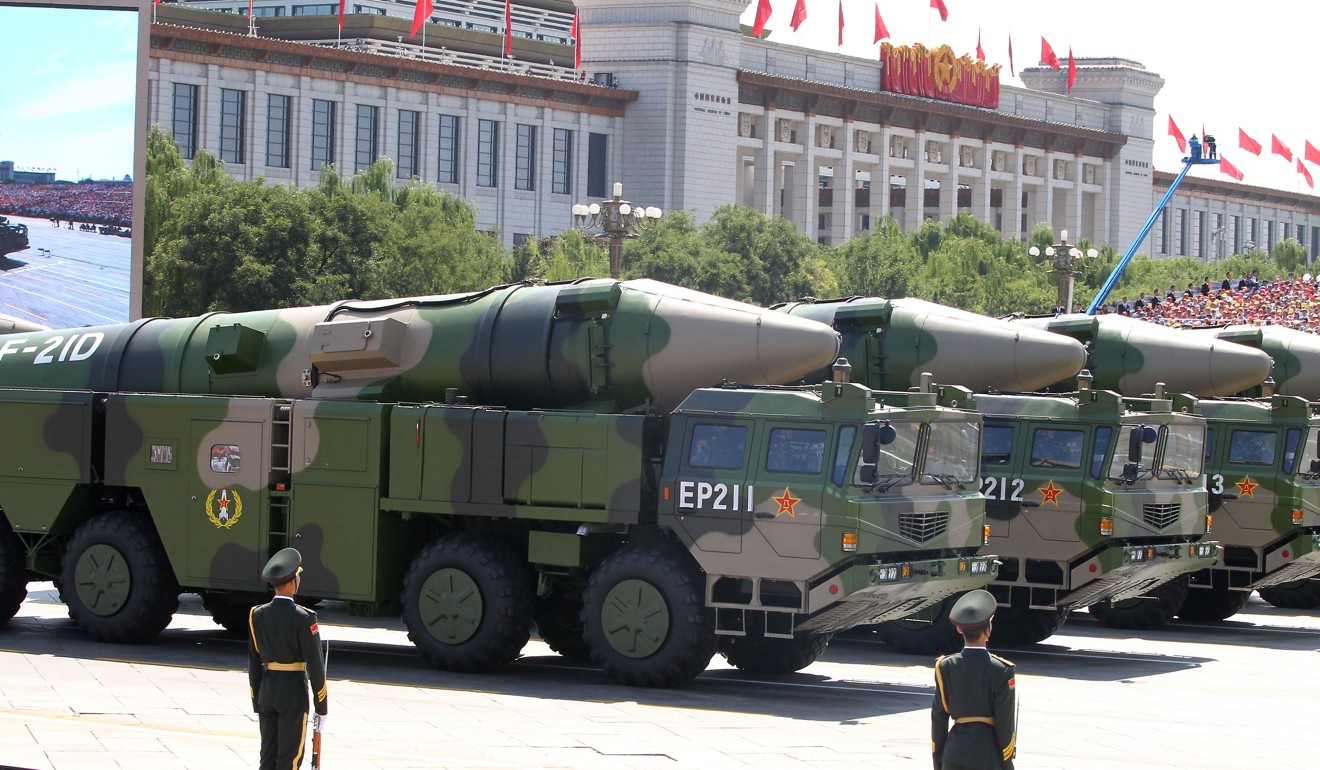
China’s new aircraft carrier set to miss 70th anniversary parade as sea trials continue
- Domestically developed Type 001A unlikely to be ready before the end of the year, experts say
- Naval parade is planned for October 1 to celebrate founding of the People’s Republic of China in 1949
China’s first home-grown aircraft carrier will not be ready in time to take part in the naval parade planned as part of the celebrations to mark the 70th anniversary of the founding of the People’s Republic of China, military sources said.
Observers say the vessel, known as the Type 001A, has yet to complete its sea trials, although there have been no statements to that effect from the People’s Liberation Army, China’s military.
“Based on its current progress [in its sea trials], the carrier won’t appear on October 1 [China’s National Day]. It’s more likely the giant ship will be ready by the end of the year, and then be formally commissioned into the navy,” a person familiar with the project said.
“I am disappointed with such a result, but it’s a fact that the Type 001A is not on the weapons list for the National Day celebration,” said the source, who spoke on condition of anonymity.
“The ship needs to complete a series of laborious and comprehensive tests, which is the most important stage in proving it is a real battleship.”
Where once Beijing might have allowed military hardware that was still under development to take part, for public relations reasons, in a high-profile parade such as the one planned for October, the Central Military Commission (CMC), headed by President Xi Jinping, now sets much higher standards, according to Beijing-based naval expert Li Jie.
“The CMC demands all new weapons undergo a series of strict tests and trials, and no longer allows these things to be rushed through so they [the hardware] are ready by a certain date or so they can take part in a parade,” he said.

The 65,000-tonne Type 001A, which was launched in April 2017, has already completed at least six rounds of sea trials, but Li said it had yet to meet its “initial operating capability” (IOC) requirements.
“The Liaoning [which China bought from Russia] was designed as a training and experimental warship and only met the IOC requirements after several years of sea trials,” Li said.
“Some of the electronic warfare systems and other equipment were upgraded in the latest revamp but even now, no one would dare to say it is a real battle-ready carrier.”

Despite the debate over the combat readiness or capabilities of the Liaoning and Type 001A, Lu Li-shih, a retired lieutenant commander with the Taiwanese navy, said the PLA Navy’s current focus was preparing carrier strike groups – the name given to the squadron of vessels that support the operations of an aircraft carrier.
“Aircraft carriers are not the PLA Navy’s current priority, but rather training their strike groups, including destroyers, frigates, submarines and supply ships,” he said.
“The carrier battle groups’ fighting capabilities were boosted with the arrival of the new Type 055 guided-missile destroyer, which went into service in April,” Lu said, referring to the largest vessel of its class in the Chinese fleet.
Chinese navy tests Z-20 helicopter for use on warships
Part of the training programme for the strike groups had involved sending the vessels to areas of the South China Sea and Pacific Ocean where they could evade detection by foreign reconnaissance systems, according to a military insider who spoke on condition of anonymity.
The selected areas included the southeast corner of Taiwan’s air defence identification zone in the South China Sea, which was out of range of the self-ruled island’s radar systems, he said.
Lu agreed, saying the navy was “choosing to conduct its drills in waters where maritime communication radar systems from Taiwan, Japan and South Korea, as well as other US allies, could not detect them”.
“The only way to watch them is with surveillance satellites, but it’s technically impossible for a US satellite to monitor a moving flotilla on the high seas 24 hours a day,” he said.
The move towards a more clandestine style is in stark contrast to the military exercises of the past when Beijing was keen to show off its military prowess to the world, Lu said.
“The [new style of] drills show the military is playing down its previous high-profile ‘Amazing China’ propaganda campaign,” he said.

Another Beijing-based source with close links to the PLA Navy said China was playing a game of hide-and-seek with the US.
“The naval flotillas only drill when the US satellites are monitoring the Middle East, Russia or some other place,” the person said on condition of anonymity.
“So it’s almost impossible for the US spy satellites to ascertain the whereabouts of Chinese warships when they are on the high seas.”
China denies US accusations of South China Sea missile tests
The choice of route meant the group passed close to the US naval base at Guam, which forms part of the “island chain” designed to contain China.
“Since last year, the navy’s high-sea drills have also featured rocket and strategic support forces, suggesting they are conducting missile tests of weapons like the DF-21D,” Lu said.
The DF-21D, also known as the “aircraft carrier killer”, is a land-based missile with a range of 1,500km (930 miles).
As for what might be on show at the National Day parade, two military insiders said in May that the cast list was likely to include more tactical – battlefield – weapons than strategic arms designed to threaten assets like infrastructure, so as to avoid upsetting the United States.

